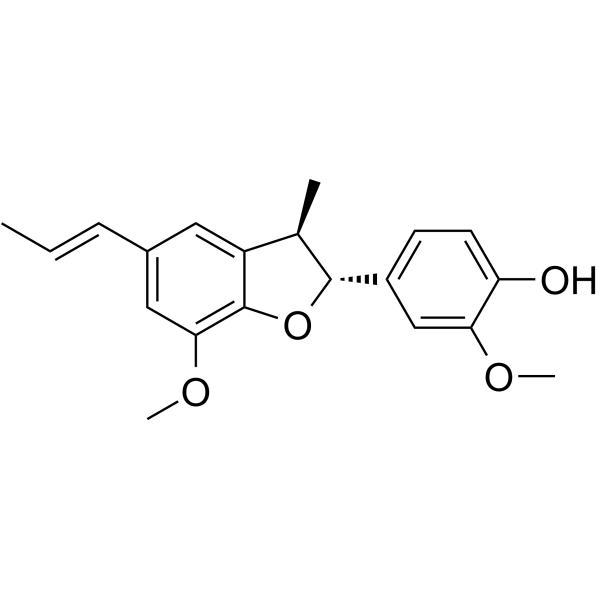天然产物 天然产物苯丙素类 Phenylpropanoids
Licarin A (Synonyms: (+)-Licarin A) 纯度: 98.16%
Licarin A ((+)-Licarin A) 显着降低二硝基苯肼-人血清白蛋白 (DNP-HSA) 刺激的 RBL-2H3 细胞。具有抗过敏作用。Licarin A 降低 TNF-α 和 PGD2 产生,和 COX-2 表达。

Licarin A Chemical Structure
CAS No. : 51020-86-1
| 规格 | 价格 | 是否有货 | 数量 |
|---|---|---|---|
| 1 mg | ¥1300 | In-stock | |
| 5 mg | ¥3200 | In-stock | |
| 10 mg | 询价 | ||
| 50 mg | 询价 |
* Please select Quantity before adding items.
Licarin A 相关产品
•相关化合物库:
- Natural Product Library Plus
- Bioactive Compound Library Plus
- Apoptosis Compound Library
- GPCR/G Protein Compound Library
- Immunology/Inflammation Compound Library
- Natural Product Library
- Anti-Aging Compound Library
- Differentiation Inducing Compound Library
- Phenols Library
- Traditional Chinese Medicine Monomer Library
- Angiogenesis Related Compound Library
| 生物活性 |
Licarin A ((+)-Licarin A), a neolignan, significantly and dose-dependently reduces TNF-α production (IC50=12.6 μM) in dinitrophenyl-human serum albumin (DNP-HSA)-stimulated RBL-2H3 cells. Anti-allergic effects. Licarin A reduces TNF-α and PGD2 production, and COX-2 expression[1]. |
|---|---|
| 体外研究 (In Vitro) |
Licarin A is found in plants such as Aristolochia taliscana, Machilus thunbergii and Myristica fragrans, which are used as spices and in folk medicines for nervous and digestive disorders. Licarin A also exhibits anti-inflammatory effects[1]. MCE has not independently confirmed the accuracy of these methods. They are for reference only. |
| 分子量 |
326.39 |
| Formula |
C20H22O4 |
| CAS 号 |
51020-86-1 |
| 中文名称 |
里卡灵 A |
| 运输条件 |
Room temperature in continental US; may vary elsewhere. |
| 储存方式 |
4°C, protect from light *In solvent : -80°C, 6 months; -20°C, 1 month (protect from light) |
| 参考文献 |
|
